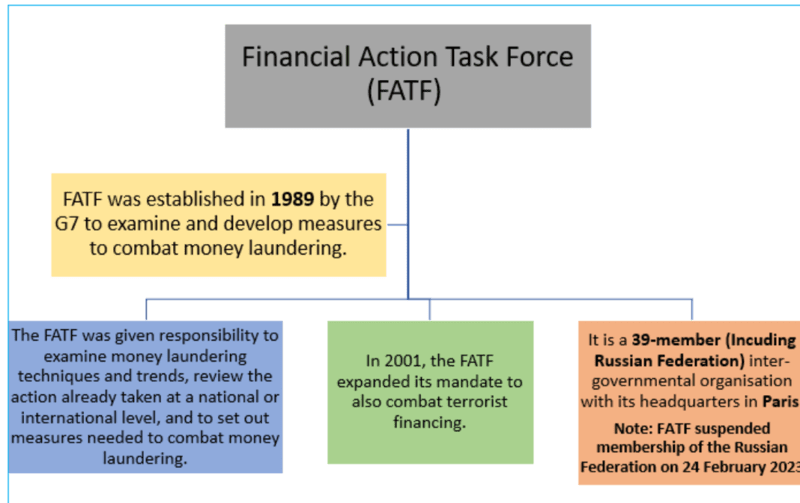GS Paper III
News Excerpt
Recently, in the 'Crowdfunding for Terrorism Financing' report, the Financial Action Task Force (FATF) highlighted that a “violent extremist organisation under investigation” in India collected funds through “well-structured networks,” including offline and online fundraising mechanisms such as circulating QR codes and account details.
Key points:
- The FATF report referred to the Popular Front of India (PFI) as having resorted to a solicitation for funds at mosques and public places, which were ultimately used to procure arms and ammunition and for training the cadres. However, FATF has not mentioned its name directly in the report.
- According to FATF, Indian officials reported that a violent extremist organization under investigation collected funds through well-structured networks spanning the entire country.
- According to FATF, the group’s fundraising tactics included offline and online mechanisms, such as circulating QR codes and account details through which donors were asked to send money. Over 3,000 bank accounts and informal value transfer systems were used. The accounts involved domestic and foreign transactions, making this case extremely difficult to investigate.
- These funds were ultimately used to procure arms and ammunition and train the cadres of the violent extremist organisation, among other purposes. A portion of the funds raised through crowdfunding was also invested and parked in businesses and real estate projects to generate regular income for terrorism activities.
- In September 2022, the Ministry of Home Affairs declared the PFI, along with its associates, affiliates, or fronts, an “unlawful association” under Section 3 of the Unlawful Activities (Prevention) Act, 1967.
Violent extremist organisation
- The phenomenon of violent extremism is multifaceted and influenced by several political, social, economic, and ideological elements.
- Violent extremist organisations are groups that use violence to try to take advantage of current discontent to present their ideology as the answer to the many issues that people or communities confront.
- For example, terrorist groups such as the Islamic State in Iraq and the Levant (ISIL), Al-Qaida, Boko Haram, etc. are violent extremists working as violent extremist organisations.
Reasons for the emergence of violent extremism
- Nothing can justify violent extremism, but we must also acknowledge that it does not arise in a vacuum.
- Narratives of grievance, actual or perceived injustice, promised empowerment, and sweeping change become attractive where human rights are being violated, good governance is being ignored, and aspirations are being crushed.
Impact of the emergence of such organisations
- It undermines peace and security, human rights, and sustainable development. No country or region is immune from its impacts.
- The spread of violent extremism has further aggravated an unprecedented humanitarian crisis that surpasses the boundaries of any one region.
- Millions of people have fled the territory controlled by terrorist and violent extremist groups.
- Migratory flows have increased both away from and towards the conflict zones, involving those seeking safety and those lured into the conflict as foreign terrorist fighters, further destabilising the regions concerned.

Steps taken by the international community to prevent extremism
- In resolution 77/243, the General Assembly decided to proclaim February 12 as the International Day for the Prevention of Violent Extremism to raise awareness of the dangers of violent extremism.
- The General Assembly emphasized in this context the primary responsibility of the Member States and their respective national institutions in countering terrorism. It underlined the vital role of intergovernmental organisations, civil society, academia, religious leaders, and the media in countering terrorism and preventing violent extremism as and when conducive to terrorism.
- On February 12, 2016, the General Assembly adopted a resolution for the Plan of Action to Prevent Violent Extremism.
- The Plan of Action calls for a comprehensive approach encompassing not only essential security-based counter-terrorism measures but also systematic preventive steps to address the underlying conditions that drive individuals to radicalise and join violent extremist groups.
Steps taken by India to stop extremism
- Fake Indian Currency Notes (FICN): An FICN Coordination Centre Cell (FCORD) is functioning in the Ministry of Home Affairs to share intelligence and information among the security agencies of the Center and States to counter the problem of the circulation of fake currency notes.
- A Terror Funding and Fake Currency (TFFC) Cell is functioning under the National Investigation Agency (NIA) to conduct a focused investigation of terror funding and fake currency cases.
- Security Related Expenditure (SRE) Scheme: This scheme is being implemented as a sub-scheme of the umbrella scheme ‘Modernization of Police Forces’. The SRE Scheme aims at strengthening the capacity of the LWE-affected states to fight the LWE menace effectively.
- Special Central Assistance (SCA) for most LWE-affected districts: This scheme was approved in 2017, and the main objective of the scheme is to fill the critical gaps in public infrastructure and services, which are of an emergent nature.
- Special Infrastructure Scheme (SIS): Under the scheme, funds are provided to states for strengthening the infrastructure related to security.
- Scheme of Fortified Police Stations: Under the scheme, 400 fortified police stations have been constructed in 10 LWE-affected states.
- Civic Action Programme (CAP): This scheme is being implemented to bridge the gaps between Security Forces (SF) and local people through personal interaction and bring the human face of SFs before the local population.
- Aspirational District: The Ministry of Home Affairs has been tasked with monitoring the Aspirational District's program in 35 LWE-affected communities.
Way forward
- Particular focus should be put on women, youth, local stakeholders, and civil society, including religious and community leaders.
- Initiatives aimed at integrating individuals willing to leave violent extremism behind and return to their communities should also be enhanced and encouraged.
- Sustainable peace can be built through safeguarding human rights, building inclusive societies, and strengthening resilience against recruitment by violent extremist groups and ideologies in local communities.
